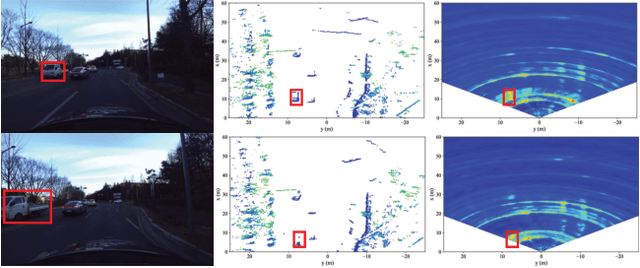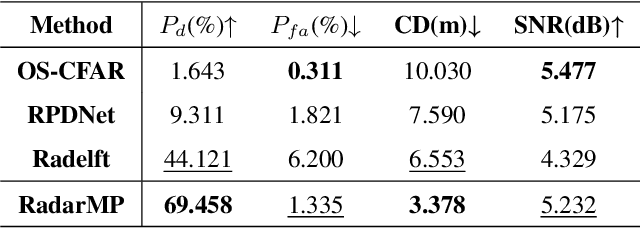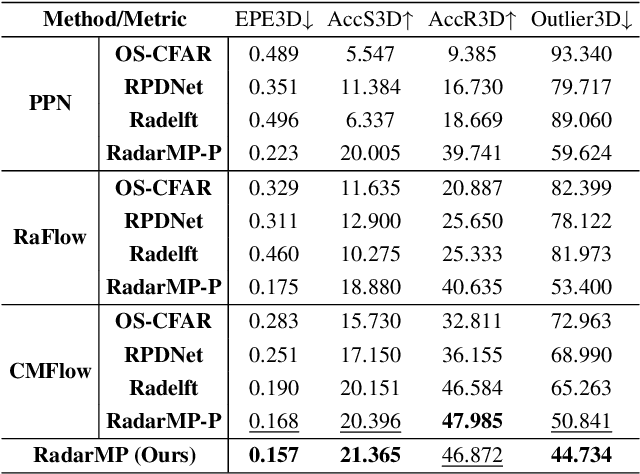Wei Liang
Human Motion Estimation with Everyday Wearables
Dec 24, 2025Abstract:While on-body device-based human motion estimation is crucial for applications such as XR interaction, existing methods often suffer from poor wearability, expensive hardware, and cumbersome calibration, which hinder their adoption in daily life. To address these challenges, we present EveryWear, a lightweight and practical human motion capture approach based entirely on everyday wearables: a smartphone, smartwatch, earbuds, and smart glasses equipped with one forward-facing and two downward-facing cameras, requiring no explicit calibration before use. We introduce Ego-Elec, a 9-hour real-world dataset covering 56 daily activities across 17 diverse indoor and outdoor environments, with ground-truth 3D annotations provided by the motion capture (MoCap), to facilitate robust research and benchmarking in this direction. Our approach employs a multimodal teacher-student framework that integrates visual cues from egocentric cameras with inertial signals from consumer devices. By training directly on real-world data rather than synthetic data, our model effectively eliminates the sim-to-real gap that constrains prior work. Experiments demonstrate that our method outperforms baseline models, validating its effectiveness for practical full-body motion estimation.
RadarMP: Motion Perception for 4D mmWave Radar in Autonomous Driving
Nov 15, 2025



Abstract:Accurate 3D scene motion perception significantly enhances the safety and reliability of an autonomous driving system. Benefiting from its all-weather operational capability and unique perceptual properties, 4D mmWave radar has emerged as an essential component in advanced autonomous driving. However, sparse and noisy radar points often lead to imprecise motion perception, leaving autonomous vehicles with limited sensing capabilities when optical sensors degrade under adverse weather conditions. In this paper, we propose RadarMP, a novel method for precise 3D scene motion perception using low-level radar echo signals from two consecutive frames. Unlike existing methods that separate radar target detection and motion estimation, RadarMP jointly models both tasks in a unified architecture, enabling consistent radar point cloud generation and pointwise 3D scene flow prediction. Tailored to radar characteristics, we design specialized self-supervised loss functions guided by Doppler shifts and echo intensity, effectively supervising spatial and motion consistency without explicit annotations. Extensive experiments on the public dataset demonstrate that RadarMP achieves reliable motion perception across diverse weather and illumination conditions, outperforming radar-based decoupled motion perception pipelines and enhancing perception capabilities for full-scenario autonomous driving systems.
M^3Detection: Multi-Frame Multi-Level Feature Fusion for Multi-Modal 3D Object Detection with Camera and 4D Imaging Radar
Oct 31, 2025Abstract:Recent advances in 4D imaging radar have enabled robust perception in adverse weather, while camera sensors provide dense semantic information. Fusing the these complementary modalities has great potential for cost-effective 3D perception. However, most existing camera-radar fusion methods are limited to single-frame inputs, capturing only a partial view of the scene. The incomplete scene information, compounded by image degradation and 4D radar sparsity, hinders overall detection performance. In contrast, multi-frame fusion offers richer spatiotemporal information but faces two challenges: achieving robust and effective object feature fusion across frames and modalities, and mitigating the computational cost of redundant feature extraction. Consequently, we propose M^3Detection, a unified multi-frame 3D object detection framework that performs multi-level feature fusion on multi-modal data from camera and 4D imaging radar. Our framework leverages intermediate features from the baseline detector and employs the tracker to produce reference trajectories, improving computational efficiency and providing richer information for second-stage. In the second stage, we design a global-level inter-object feature aggregation module guided by radar information to align global features across candidate proposals and a local-level inter-grid feature aggregation module that expands local features along the reference trajectories to enhance fine-grained object representation. The aggregated features are then processed by a trajectory-level multi-frame spatiotemporal reasoning module to encode cross-frame interactions and enhance temporal representation. Extensive experiments on the VoD and TJ4DRadSet datasets demonstrate that M^3Detection achieves state-of-the-art 3D detection performance, validating its effectiveness in multi-frame detection with camera-4D imaging radar fusion.
SFGFusion: Surface Fitting Guided 3D Object Detection with 4D Radar and Camera Fusion
Oct 22, 2025Abstract:3D object detection is essential for autonomous driving. As an emerging sensor, 4D imaging radar offers advantages as low cost, long-range detection, and accurate velocity measurement, making it highly suitable for object detection. However, its sparse point clouds and low resolution limit object geometric representation and hinder multi-modal fusion. In this study, we introduce SFGFusion, a novel camera-4D imaging radar detection network guided by surface fitting. By estimating quadratic surface parameters of objects from image and radar data, the explicit surface fitting model enhances spatial representation and cross-modal interaction, enabling more reliable prediction of fine-grained dense depth. The predicted depth serves two purposes: 1) in an image branch to guide the transformation of image features from perspective view (PV) to a unified bird's-eye view (BEV) for multi-modal fusion, improving spatial mapping accuracy; and 2) in a surface pseudo-point branch to generate dense pseudo-point cloud, mitigating the radar point sparsity. The original radar point cloud is also encoded in a separate radar branch. These two point cloud branches adopt a pillar-based method and subsequently transform the features into the BEV space. Finally, a standard 2D backbone and detection head are used to predict object labels and bounding boxes from BEV features. Experimental results show that SFGFusion effectively fuses camera and 4D radar features, achieving superior performance on the TJ4DRadSet and view-of-delft (VoD) object detection benchmarks.
Learning Human-Humanoid Coordination for Collaborative Object Carrying
Oct 16, 2025Abstract:Human-humanoid collaboration shows significant promise for applications in healthcare, domestic assistance, and manufacturing. While compliant robot-human collaboration has been extensively developed for robotic arms, enabling compliant human-humanoid collaboration remains largely unexplored due to humanoids' complex whole-body dynamics. In this paper, we propose a proprioception-only reinforcement learning approach, COLA, that combines leader and follower behaviors within a single policy. The model is trained in a closed-loop environment with dynamic object interactions to predict object motion patterns and human intentions implicitly, enabling compliant collaboration to maintain load balance through coordinated trajectory planning. We evaluate our approach through comprehensive simulator and real-world experiments on collaborative carrying tasks, demonstrating the effectiveness, generalization, and robustness of our model across various terrains and objects. Simulation experiments demonstrate that our model reduces human effort by 24.7%. compared to baseline approaches while maintaining object stability. Real-world experiments validate robust collaborative carrying across different object types (boxes, desks, stretchers, etc.) and movement patterns (straight-line, turning, slope climbing). Human user studies with 23 participants confirm an average improvement of 27.4% compared to baseline models. Our method enables compliant human-humanoid collaborative carrying without requiring external sensors or complex interaction models, offering a practical solution for real-world deployment.
Spatial-Temporal Multi-Scale Quantization for Flexible Motion Generation
Aug 12, 2025Abstract:Despite significant advancements in human motion generation, current motion representations, typically formulated as discrete frame sequences, still face two critical limitations: (i) they fail to capture motion from a multi-scale perspective, limiting the capability in complex patterns modeling; (ii) they lack compositional flexibility, which is crucial for model's generalization in diverse generation tasks. To address these challenges, we introduce MSQ, a novel quantization method that compresses the motion sequence into multi-scale discrete tokens across spatial and temporal dimensions. MSQ employs distinct encoders to capture body parts at varying spatial granularities and temporally interpolates the encoded features into multiple scales before quantizing them into discrete tokens. Building on this representation, we establish a generative mask modeling model to effectively support motion editing, motion control, and conditional motion generation. Through quantitative and qualitative analysis, we show that our quantization method enables the seamless composition of motion tokens without requiring specialized design or re-training. Furthermore, extensive evaluations demonstrate that our approach outperforms existing baseline methods on various benchmarks.
CLONE: Closed-Loop Whole-Body Humanoid Teleoperation for Long-Horizon Tasks
Jun 10, 2025Abstract:Humanoid teleoperation plays a vital role in demonstrating and collecting data for complex humanoid-scene interactions. However, current teleoperation systems face critical limitations: they decouple upper- and lower-body control to maintain stability, restricting natural coordination, and operate open-loop without real-time position feedback, leading to accumulated drift. The fundamental challenge is achieving precise, coordinated whole-body teleoperation over extended durations while maintaining accurate global positioning. Here we show that an MoE-based teleoperation system, CLONE, with closed-loop error correction enables unprecedented whole-body teleoperation fidelity, maintaining minimal positional drift over long-range trajectories using only head and hand tracking from an MR headset. Unlike previous methods that either sacrifice coordination for stability or suffer from unbounded drift, CLONE learns diverse motion skills while preventing tracking error accumulation through real-time feedback, enabling complex coordinated movements such as ``picking up objects from the ground.'' These results establish a new milestone for whole-body humanoid teleoperation for long-horizon humanoid-scene interaction tasks.
MetaScenes: Towards Automated Replica Creation for Real-world 3D Scans
May 05, 2025Abstract:Embodied AI (EAI) research requires high-quality, diverse 3D scenes to effectively support skill acquisition, sim-to-real transfer, and generalization. Achieving these quality standards, however, necessitates the precise replication of real-world object diversity. Existing datasets demonstrate that this process heavily relies on artist-driven designs, which demand substantial human effort and present significant scalability challenges. To scalably produce realistic and interactive 3D scenes, we first present MetaScenes, a large-scale, simulatable 3D scene dataset constructed from real-world scans, which includes 15366 objects spanning 831 fine-grained categories. Then, we introduce Scan2Sim, a robust multi-modal alignment model, which enables the automated, high-quality replacement of assets, thereby eliminating the reliance on artist-driven designs for scaling 3D scenes. We further propose two benchmarks to evaluate MetaScenes: a detailed scene synthesis task focused on small item layouts for robotic manipulation and a domain transfer task in vision-and-language navigation (VLN) to validate cross-domain transfer. Results confirm MetaScene's potential to enhance EAI by supporting more generalizable agent learning and sim-to-real applications, introducing new possibilities for EAI research. Project website: https://meta-scenes.github.io/.
EMRModel: A Large Language Model for Extracting Medical Consultation Dialogues into Structured Medical Records
Apr 23, 2025Abstract:Medical consultation dialogues contain critical clinical information, yet their unstructured nature hinders effective utilization in diagnosis and treatment. Traditional methods, relying on rule-based or shallow machine learning techniques, struggle to capture deep and implicit semantics. Recently, large pre-trained language models and Low-Rank Adaptation (LoRA), a lightweight fine-tuning method, have shown promise for structured information extraction. We propose EMRModel, a novel approach that integrates LoRA-based fine-tuning with code-style prompt design, aiming to efficiently convert medical consultation dialogues into structured electronic medical records (EMRs). Additionally, we construct a high-quality, realistically grounded dataset of medical consultation dialogues with detailed annotations. Furthermore, we introduce a fine-grained evaluation benchmark for medical consultation information extraction and provide a systematic evaluation methodology, advancing the optimization of medical natural language processing (NLP) models. Experimental results show EMRModel achieves an F1 score of 88.1%, improving by49.5% over standard pre-trained models. Compared to traditional LoRA fine-tuning methods, our model shows superior performance, highlighting its effectiveness in structured medical record extraction tasks.
Improved AFSA-Based Beam Training Without CSI for RIS-Assisted ISAC Systems
Apr 10, 2025Abstract:In this paper, we consider transmit beamforming and reflection patterns design in reconfigurable intelligent surface (RIS)-assisted integrated sensing and communication (ISAC) systems, where the dual-function base station (DFBS) lacks channel state information (CSI). To address the high overhead of cascaded channel estimation, we propose an improved artificial fish swarm algorithm (AFSA) combined with a feedback-based joint active and passive beam training scheme. In this approach, we consider the interference caused by multipath user echo signals on target detection and propose a beamforming design method that balances both communication and sensing performance. Numerical simulations show that the proposed AFSA outperforms other optimization algorithms, particularly in its robustness against echo interference under different communication signal-to-noise ratio (SNR) constraints.
 Add to Chrome
Add to Chrome Add to Firefox
Add to Firefox Add to Edge
Add to Edge